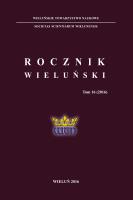Celtyckie militaria w kulturze przeworskiej z obszaru Wielkopolski wschodniej i Polski środkowej
Celtic military artefacts in the Przeworsk culture from eastern Greater Poland and central Poland
Author(s): Lubomira TyszlerSubject(s): Cultural history, Military history
Published by: Wieluńskie Towarzystwo Naukowe
Summary/Abstract: In the study was presented a review of Celtic military artefacts as well as military artefacts pro- duced in Celtic tradition from the area between the Prosna River, meridional section of the Warta River and the upper Bzura River. The main category of artefacts constitute two-edged swords (sets of swords with scabbards, swords, and scabbards) counting about 50 specimens, dated to phases A1, A2, A3 and stage A3/ B1 (tables 1, 2). The work by T. Bochnak (2014) is the basis of criteria for identification and typology of military artefacts. In the zone of the Prosna River swords are often accompanied by elements of Celtic sword belts (table 3). Amongst other categories of imports stand out unique in the non-Celtic areas, eastern Celtic helmets of type Novo Mesto from Siemiechów, grave 25 (phase A3) and halberd-like axe from Alpine areas from Ciecierzyn, grave 20 (phase A3). From Witaszewice (grave 147/1937) comes scabbard of type Zemplín constituting a proof of presence of imports in the La Tène tradition, as late as in phase B1 of the Roman period. Its important feature is use of new production solutions. Process of transition to Roman technology, including the weapons production, took place, amongst others, in Celtic workshops in Magdalensberg after incorporation of Regnum Noricum to the Roman state. Noricum’s significant position manifests itself on the Amber Road by so-called Noricum wave of imports, amongst others, in the area discussed in the study. These are two-edged swords’ scab- bards decorated with mounts made in the opus interrasile technique. With this wave arrived a specimen of Roman sword which bears the stamp ALLIVS PA, constituting a specific heritage of Celtic swords, discovered in Wesółki, grave 3 (phase A3). It can be assumed that it was produced in one of fabrica operating in Magdalensberg, where in the military artefacts production were engaged Celtic and Italian blacksmiths. The area between the Prosna River and the Warta River remained well connected with the Celtic zone through the Amber Road. The overview of settlement relations in connection with finds distribution leads to the conclusion that the leading role was played by a section of the Road along the Prosna River, while a system of branches operating in this region enabled transfer of military artefacts to the Warta River zone and further to the upper Bzura River zone. The privileged position of the Prosna River in relation to the rest of the zone define the indicators in quantity and percentage terms, respectively: 67% : 33% (36:18) (tables 5, 6). The concentration of Celtic swords, often with distinctive sword belts, in the zone of the Amber Road evidences the existence of groups of warriors engaged in its protection. The combat strength provided high quality equipment obtained through trade. The dynamics of inflow of imported military artefacts, mainly swords, in individual phases A1, A2, A3 and stage A3/B1 is expressed by numbers, respectively 3:17:28 (tables 4, 6). Applying the time coefficient, in turn, the following values were obtained: for A1 - 5.5, for A2 - 20 and for A3 and A3 / B1 - 40. This means that an increased inflow of military artefacts occurred only in phase A2 (A1/A2, A2 ), while the apogee of contacts comprises phase A3 and stage A3/B1. At the end of the younger pre-Roman period (LT D2) the interest in the exploitation of the goods on the Road significantly heightened, amongst others due to Celtic immigrants who settled in the area of Kalisz.
Journal: Rocznik Wieluński
- Issue Year: 16/2016
- Issue No: 16
- Page Range: 29-52
- Page Count: 24
- Language: Polish

